Security Chapter 12
24 Slides246.50 KB
Security Chapter 12
What Should I Ask Santa Claus For? e-mail spoofing: fraudulent e-mail activity in which the sender address and other parts of the e-mail header are altered to appear as though the e-mail originated from a different source 2
Phishing phishing: scam by which an e-mail user is duped into revealing sensitive information such as passwords and credit card details Link might go to another website (links are easy to spoof); hover mouse over links to see where they lead 3
What Can Be Done About Phishing? Never respond to requests for personal information like passwords via e-mail (or phone!). Legitimate businesses do not request such information this way. Visit web sites of companies with which you have business by manually typing the company URL. Do not click on links in unexpected e-mails because they can be spoofed. Along the same lines, do not call phone numbers found in those e-mails. 4
What Can Be Done About Phishing? Be leery of URLs that do not have the company name directly before the top-level domain. Routinely review your credit card and bank statements for unusual activity. For example, bankofamerica.com is the correct URL, bankofamerica.pp.com is questionable. http://annualcreditreport.com "Recognizing Phishing Scams and Fraudulent / Hoax Email" http://www.microsoft.com/protect/yourself/ phishing/identify.mspx 5
How Often Should You Change Your Passwords? https://uwnetid.washington.edu/manage/ Can't an attacker (perhaps using a computer program) keep guessing passwords? Computer systems usually impose a time-out of several seconds after a number (e.g. three) failed attempts. "Top 10 Most Common Passwords" http://modernl.com/article/top-10-most-common-passwords 6
Social Engineering social engineering: the act of manipulating people into performing actions or divulging confidential information 7
Password Insecurity Source: "Palin E-Mail Hacker Says It Was Easy" http://blog.wired.com/27bstroke6/2008/09/palin-e-mailha.html "As detailed in the postings, the Palin hack didn't require any real skill. Instead, the hacker simply reset Palin's password using her birthdate, ZIP code and information about where she met her spouse -the security question on her Yahoo account, which was answered (Wasilla High) by a simple Google search." 8
Malware malware (malicious software): software designed to infiltrate or damage a computer system without the owner's informed consent computer virus: catch-all phrase to include all types of malware, including true viruses Other terms for baddies: trojan horse, worm, adware, spyware 9
How Malware Spreads Some malware can be secretly installed just by visiting infected web sites. Others require human intervention to propagate (e.g. clicking on an e-mail attachment or installing infected software) 10
How Malware Spreads USB drives can be carriers of computer viruses. Window that pops up when you insert an infected USB drive looks similar to that when inserting a clean USB drive. Clicking icon infects the computer. To prevent further infection, click the X on the top right. However clean drives can still be infected just by using the USB drive with an infected computer. 11
What's The Worst That Could Happen? keylogger: software that can capture and record user keystrokes backdoor: hidden method for bypassing normal computer authentication systems zombie: computer attached to the Internet that has been compromised denial-of-service attack (DoS attack): attempt to make a computer resource unavailable 12
Preventative Tips Show hidden files. If you do not know what a file is for, look it up on the web. http://www.microsoft.com/windowsxp/using/ helpandsupport/learnmore/tips/hiddenfiles.mspx Do not open unexpected e-mail attachments. Be wary of pop-up windows that ask you to install something (like anti-virus software) if you are just surfing the web. 13
Preventative Tips Keep your system up-to-date. Newer systems automatically update. Verify that your computer automatically updates or make sure to manually update every so often. http://windowsupdate.microsoft.com If you must use IE, use the latest version. 14
Useful Software: Firewall firewall: software which inspects network traffic passing through it, and denies or permits passage based on a set of rules Most systems have firewalls installed. 15
Useful Software "Protecting your computer from viruses" http://www.washington.edu/computing/virus.html Contains link to anti-virus software for both Mac and Windows Additional Windows Software Ad-Aware Spybot – Search & Destroy AVG Anti-Virus 16
An Ongoing Battle 17
Cleaning Viruses Anti-virus software is only good if you keep it up-todate. In certain cases, you may have to clean a virus manually. New viruses are coming out all the time. Try to find respectable directions on the web. The process can be very tedious. Computer Vet http://www.washington.edu/computing/computervet/ 18
For Your Security Don't save important passwords in your browser. What if someone steals your computer? 19
Secure Protocols Hypertext Transfer Protocol Secure (HTTPS): combination of HTTP and a network security protocol URL begins with https:// notice the 's' lock indicates secure website 20
Spam! spam: unsolicited or undesired electronic messages Usually sent by zombie computers. 21
Is Anyone Dumb Enough To Respond To Spam? One study showed that the hit rate for pharmaceutical spam is about 1 in 12 million. Source: "Spamalytics: An Empirical Analysis of Spam Marketing Conversion" http://www.icsi.berkeley.edu/pubs/networking/200 8-ccs-spamalytics.pdf Spam Targets: 347,590,389 User Conversions: 28 (0.0000081%) 22
Preventing Spam CAPTCHA: Completely Automated Public Turing test to tell Computers and Humans Apart 23
E-mail Some e-mail programs do not show certain images in the e-mail unless you press another button. Why? This concern images that have to be downloaded from another source (vs. just being attached to the e-mail). Fetching images can alert the sender that the email address is valid. So what? Spammers love valid e-mail addresses! 24





























